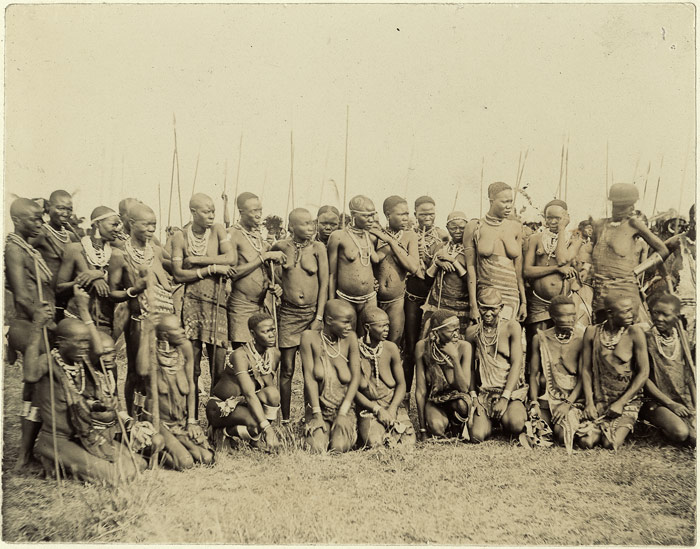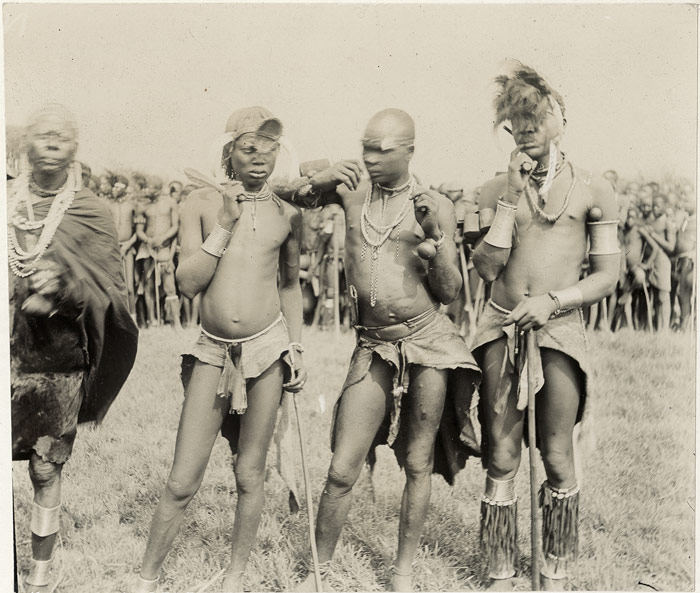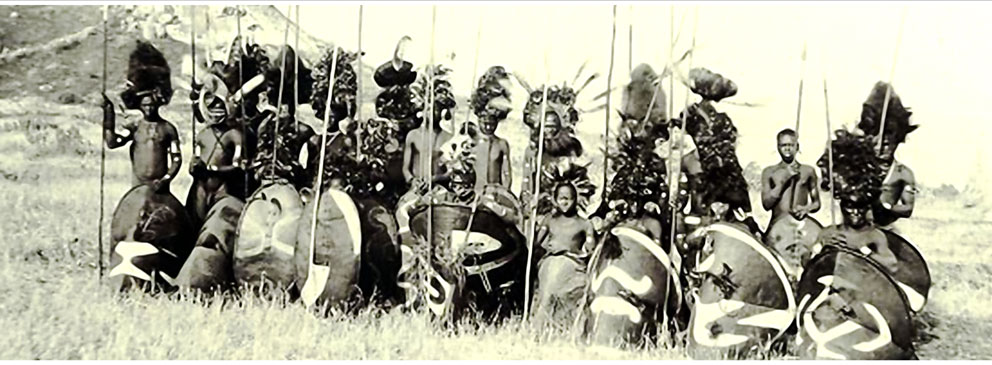


THE JO-LUO
The geopolitics, social interaction, intermarriages, boundaries, climates, destinations, and resources have made it difficult for Sociologists, Anthropologists and Archaeologists to study these large ethnic Luo groups within the African continent. Most of ethnologists, who have attempted to study the Luo ethnic groups, have focused their studies within limited scope of geographical areas, and with emphasis on a particular Luo sub-group instead of the whole groups. Targeted population studied were always a clan or section of a group within one of the countries that are currently known as home for the Luo ethnic groups in Africa. Many understand that by focussing on sub groups, or section within one country, make the study somehow feasible and attainable with limited resources.
Further, the history of ethnic Luo groups migration, and their ethnographic distributions over six African countries (Kenya, Tanzania, Uganda, Congo, Sudan and Ethiopia) has left most Social Scientists, including Luo people themselves with lots of unanswered questions on the causes of groups disintegrations and lack of more facts about the country of their origin in Africa. (Murrdock, Peter George: 1959)
The causes of the groups’ migration have been shaped up, and cited through oral history, myth and elders accounts. In addition, the biases of studying people with no history, or references in social sciences, have made it even harder to study not only the Luo ethnic groups in Africa, but also many other ethnic groups within the continent.
The Luo ethnic groups have reconstructed themselves as independent groups and clans, assimilated within other ethnic groups and integrated other groups like Lango, Kumam in Uganda, and Dinka in Sudan into the larger Luo ethnic groups. As such, the process of tracing Luo ethnic ancestry will also remain to be a major task and challenge for those Ethnologists concerns of tracing the roots and ancestors of the Luo groups in Africa. Furthermore, with continuation of the process and cycle of social assimilation among the various ethnic groups in Africa, it is presumed that the question of tracing the ancestries of these groups would continue to complicate with the factor of time, urbanization and intermarriages (Pace, Wanda: 1991)
Ethnographer like St. Andrea (1938), Ogot (1967), Gilly (1992) all agreed that the ethnic Luo groups country of origin is Sudan, and most oral history and myth referred to Niykango, Dimo and Geilo as the first three ancestors that many are linked, or referred to, as the point of reference in the history of Luo ethnic groups and their origin in Africa.
The research is intending to treat Luo groups all over Africa as one major ethnic group to further encourage social science study investigations, to look at their ethnicity, origin, classifications, causes of migrations and group disintegration. My statements of observations in this work are reported with the fact that I am a member of the Luo ethnic group of western Bhar El-Ghazal (Sudan). In this sense, I would like to add my cultural experience acquired through years of socialization within Luo groups of Bhar el Ghazal. This observation is explored and supported with citations to at least resolve any doubt of group ethnicity, ethnic classification and the impact of social assimilation on the language spoken. In addition, the factors that facilitated their resettlement, and how they managed to live in peace with non-Luo ethnic groups they have encountered, as neighbours all over Africa will be further explored and discussed.
The Luo People in Africa:
Ogot (1967) dated the separation of the Luo ethnic group from East Sudanic family of “Nilotic” groups around 3000. The “Nilotics” groups according to Hambly (1970) are classified according to their languages, as it shows a “…varying degree of affinity”. Such linguistic divergence according to Raymond Atkinson (1994) is a result of Luo migration southward that led to Luo settlement in many parts of East Africa. (1994: 53)
These groups includes Dinka, Shilluk, Acholi, Bari, Latuka,Pari, Anuak, Luo-Jur and its sub-groups, to the Suk-Turkana, Nandi, Lumbwa and South Kevirondo. Contrary to mythology and Luo oral history, Ogot (1967) has attributed the demographic distribution or migration of the ethnic group over the six African countries to population explosions. The Luo ethnic groups in Africa are so far the only ethnic groups that are distributed over six African countries in forms of independent groups and clans. Their oral history and myths within these large ethnic groups refer to Sudan, as their country of origin, in particular Southern Sudan Region, state of Bahr El-Ghazal (Ogot: 1967).
Raymond Atikson (1994) dated migration of Luo ethnic groups to central Uganda between year 1500-1800, and some subsequently crossed to Kenya, Tanzania, and the Democratic Republic of Congo around the same time frame. The Luo ethnic groups did assimilate with other ethnic groups, and integrated other ethnic group into Luo ethnic groups during the course of their migration. For example, Luo Kuman (Bantus) and Lango (Nilotics) in Uganda have adopted both Luo culture and language, and the Dinka (Nilotic) in Southern Sudan became a major part of the Luo Shilluk in the Upper Nile Region. (1994)
Sudan still is a home to about seven independent Luo ethnic groups of (1) Shilluk, (Arabic pronunciation for shoulla), (2) Jo-Luo also known as (Jur) a local term which means strangers in other Southern Sudanese groups languages, (3) Anuak, or (Anwaye), (4) Baland Bor (Bori), (5) Thuri (Chatt), (6) Pari (Lokoro) and (7) Achuli (shuli). These Luo groups in Sudan are further divided into clans, Sub-Clans and kinships. The Luo ethnic group in Sudan are found in Southern Sudan, Regions of Bahr El-Gazal, Equatoria and the Upper Nile States. The research will further explore their geography and locations in details in the coming chapters. Anuak ethnic group share border with Sudan and Ethiopia as well as Acholis are found in the both Sudan Ugandan border. These ethnic groups move freely between the borders and rarely recognize the state boundaries of these respective countries: a situation imposed on them due to their colonial past. (Eisei, Kurimoto, and Seligman B.Z.:1932).
Kenya and Tanzania host the largest numbers of Luo group in Africa. The Luo ethnic group in these two countries are divided into groups and clans. These groups and clans in most part are still homogeneous and located in around lake Victoria. Most of the Luo groups in Kenya and Tanzania migrated from Central Uganda around year 1550-1800. Uganda still hosts Luo ethnic groups of Adolha, Acholi and assimilated Luo of Kowumam, and Lango. (Ogot: 1967). Acholi County is currently located in Eastern and Northern Uganda.
The democratic republic of Congo according to John Tosh (1978), hosts Luo ethnic groups of “Alur”, the group that are known in the country for their love for peace and music. The migration of Luo to the democratic Republic of Congo was dates as early as the 16th century. At the same period of time, Chief Adhola arrived with his Group known as Luo Jo-Padhola to Padama Eastern Uganda and settled there. John Tosh (1978) dated the first migration of the Luo from Southern Sudan, Nimule area in particular around fifteenth century. He states that,
“…Most groups followed the valley of the Nile until they reach Pubungu at the north end of Lake Albert. Here dispersion occurred. Some entered Bunyoro, where they established the Bito dynasty and became a dominant element in eastern Bunyoro in Uganda. Some remained on the right bank of the Victoria Nile, and slowly expanded into Luo Acholi. Others at a later date crossed into what is now Alur country in West Nile district. Meanwhile a smaller section of southern Luo had stayed behind in Nimule area, and from there they gradually spread over north Acholi…” (1978:p252)
On these remarks, Tosh (1978) has estimated the period of these patterns of Luo migration for over two centuries. In addition, his account has further illuminate the patterns of the extension of Luo migration from Southern Sudan to surrounding neighbouring African countries of Uganda, Kenya, Tanzania and Congo, which happened around 1500-1800.
J. V. Wild, (1954) gave an account of Father Grazzolara who stated that the Lwoo (Luo) have started their migration from eastern Bhar el Ghazal province, southern Sudan around 1600 to 1650. Father Grazzolara mapped the direction of the internal emigration of the larger Luo ethnic group from “…eastern Bahr el Ghazal province of Nyikang, on Bhar el Ghazal River; then through the present Shilluk, Anywah [Anuak], Bari countries to mount Kilak, Wat Latong (Pakwach), and Bunyoro to their final settlement…” where they currently live (1954: p6)
The two account of Tosh (1978) and Wild (1954) in theory supports the mythology and the Luo groups oral history, as it pertained to the direction of migration of their great ancestry namely Niykango, Dimo, and Geilo from eastern Bhar el Ghazal to where the groups are currently settled.
- Home
- ABOUT THE LUO OF BG
- Community Events
- CURRENT PROJECTS
- HOME NEWS
- DIASPORA
- LUO OF BHAR EL GHAZAL IN AMERICA
- HISTORICAL PRESPECTIVES
- OPINIONS
- CULTURE
- LUO IN AFRICA
- LUO IN SUDAN
- THE EXECUTIVE COMMITTEE
- UPDATES AND COMMENTS
- GOVERNMENT OF WESTERN BHAR EL GHAZAL
- GOVERNMENT OF NORTHERN B G
- CONTACT US
- Conference 2009
- Luo Youth Connection
- Luo Business
- Southern Sudan TV LIVE
- Jo-Luo Internet RadioTV-Live
- Luo Community Conference 2016